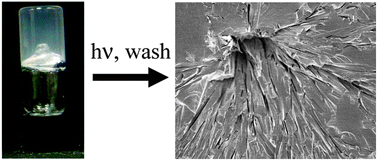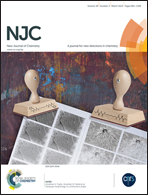Using gel morphology to control pore shape†
Abstract
Supramolecular gelators with different fibre morphologies have been used as templates to form mesoporous covalent polymers with different pore shapes. Two bis-urea derived gelators functionalised with different amino-acid groups form gels in 1 : 1 methyl methacrylate : ethylene glycol dimethacrylate (MMA : EGDMA) mixtures with either ribbon-like or cylindrical fibre morphologies. Polymerisation of the monomer produces composite materials containing the gelators. The gel template can be readily removed by washing with methanol to give porous materials in which the gel morphology is imprinted on the covalent polymer matrix. Scanning electron microscopy measurements show the resulting polymers exhibit strikingly different pore shapes corresponding to those expected for the differently shaped gel fibres. Nitrogen adsorption measurements corroborate these observations showing mesoporous materials with considerable BET surface areas, adsorption–desorption isotherms, and pore size profiles. Gelator concentration provides a ready means of controlling porosity and samples prepared at different gelator concentrations are compared. Small changes in the molecular structure of the gelator can therefore be used to produce polymeric materials with very different pore shapes, sizes and adsorption characteristics.


 Please wait while we load your content...
Please wait while we load your content...